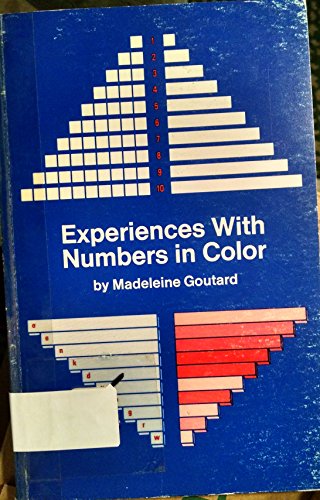 I'm rereading some of the chapters in Madeleine Goutard's Experiences With Numbers in Colour. Something jumped out at me. It was written in 1964, but in a way it's better suited to now, to 2016. The destiny of many if not most sets of Cuisenaire rods around in the 60s was to end up in the bottom of cupboards, along with the Dienes apparatus and Geoboards. What was not there, the ingredient that was needed to make the pedagogy work, was the idea and practice of number talks. Even now this is maybe not that widespread, but at least it's out there, with wonderful books like Intentional Talk leading the way. Now that we are using quick dot images, asking children to look at groups of dots and tell us how they see the total, we understand better the importance of what Goutard below calls "naturally ingenious combining".
I'm rereading some of the chapters in Madeleine Goutard's Experiences With Numbers in Colour. Something jumped out at me. It was written in 1964, but in a way it's better suited to now, to 2016. The destiny of many if not most sets of Cuisenaire rods around in the 60s was to end up in the bottom of cupboards, along with the Dienes apparatus and Geoboards. What was not there, the ingredient that was needed to make the pedagogy work, was the idea and practice of number talks. Even now this is maybe not that widespread, but at least it's out there, with wonderful books like Intentional Talk leading the way. Now that we are using quick dot images, asking children to look at groups of dots and tell us how they see the total, we understand better the importance of what Goutard below calls "naturally ingenious combining".I won't be using this particular part for a while as my five year olds will be doing a lot of playing and other things before we get to this stage. But you'll see what's happening. The class is motivated to explore something together, they are creative and playful in the way they find solutions. The emphasis is on doing and trying out rather than having remembered (although they evidently have a lot of experience with rectangles as products of two numbers).
The passage starts with Goutard introducing some rods:
She then introduced a black rod (7 white rods long)...
And not just flexibility of mental calculation. Flexibility in thinking. And also comfort with manipulating numbers. These days too it's easy enough to take photos of what the kids have made , get them up on the whiteboard, and come together to talk about the different representations together.





Hey Simon, Can I repost this on my blog and link it to yours? This is very good. There is so much in these books and it helps to have many eyes and ears pulling out the good stuff from them. It never occurred to me to take pictures and discuss it together. Duh! But I don't have enough students at one time. Though that will change in the fall. Thanks so much!
ReplyDeleteYes, do that Sonya, repost.
DeleteYou can gather the class round an individual's work but often the focus isn't good for long, I find. Looking at a pic on the whiteboard often seems more sustainable, and has the advantage that the kids can annotate it.
So, you'll be working with bigger groups this autumn?
I'm going to run an 2x weekly math class/circle for k - 1 students. I'll keep you posted.
ReplyDeleteThis is excellent Simon.
ReplyDeleteThank you for sharing the book you are reading. Have too many books I am reading right now--but am still going to order this! It will have to go to the top of the pile. The thoughtfulness of your writing always inspires me to think more carefully about my instructional decisions and to stick with what I know works.
ReplyDeleteThanks Judy.
DeleteI like Goutard's Mathematics and Children even more, which I mentioned here
http://followinglearning.blogspot.fr/2015/11/can-students-ask-and-answer-vast.html
It also has the advantage of being in print:
http://shop.cuisenaire.co.uk/blog/
Though I think what Goutard is saying is really exciting and full of promise for mathematics teaching, I also mention there a frustrations with her books: she gives guiding principles - which are great - and some examples of children's work, but to help all of us get the idea we need concrete detailed examples of lessons in progress. Transcripts of how conversations go, how classes are organised, etc. How do how can students lead the way in the lessons? There's a need for a book like that.
Thank you for sharing Simon! I want to do more work with cuisenaire rods this year with my first graders! Maybe we can work together!
ReplyDeleteGreat that you want to Jamie, and yes, let's!
DeleteThis is great! Flexibility is certainly a great trait to develop in the mind and this makes a great exercise in strengthening that trait.
ReplyDelete